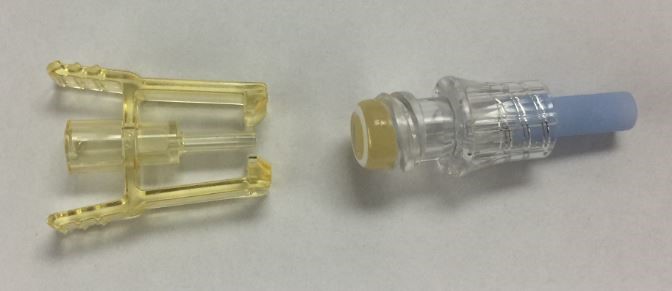New UNMC ID publication alert! #ReadUNMCID
 Recently, several members of the Division of Infectious Diseases at UNMC/Nebraska Medicine published a study in American Journal of Infection Control (AJIC) entitled: Microbial colonization of intravascular catheter connectors in hospitalized patients. Drs. Richard Hankins (former ID fellow, class of 2019), and Kelly Cawcutt (Associate Medical Director of Infection Control) are the lead and senior authors on this study. Dr. Hankins wrote this summary describing their study.
Recently, several members of the Division of Infectious Diseases at UNMC/Nebraska Medicine published a study in American Journal of Infection Control (AJIC) entitled: Microbial colonization of intravascular catheter connectors in hospitalized patients. Drs. Richard Hankins (former ID fellow, class of 2019), and Kelly Cawcutt (Associate Medical Director of Infection Control) are the lead and senior authors on this study. Dr. Hankins wrote this summary describing their study.
What is the study about?
The infection control team at Nebraska Medicine is constantly evaluating for methods to reduce central line associated blood stream infections. In 2016 we were evaluating whether our catheter connectors could have a role contributing to central line associated blood stream infections. At the time we were using a split septum catheter connector (Lever Lock, Becton Dickinson) and due to the open nature of the catheter connector diaphragm, we were concerned that this could become colonized, and then bacteria could spread down the IV tubing leading to a blood stream infection.
We then set out to assess the colonization of the split septum catheter connectors of both central and peripheral lines at Nebraska Medicine on active infusions. Catheter connectors were assessed both in intensive care units as well as the general medical/surgical wards. We avoided sampling in catheter connectors with antibiotics running or what was deemed a critical infusion (pressors). The infusion would be paused and the catheter connector diaphragm was then placed directly onto an agar place. We would do 4 impressions onto an agar plate of the same diaphragm, and due to the size of the agar plate, we were able to do 4 separate catheter connectors on each agar plate. After incubating each plate for 48-72 hours we assessed for microbial growth. We found that of the 234 catheter connectors we evaluated, 98 of them had microbial growth (41.9%). This was deemed excessively high to the point that the hospital switch from split septum catheter connectors to the luer lock catheter connector (Max Zero, Becton Dickinson) , and simultaneously instituted the alcohol infused port protector (Curos, 3M). After the switch was made, waited three months for the nursing staff to become used to working with the new catheter connectors, and then repeated the study.
What did the study find?
We found in the first phase of the study that the split septum catheter connectors were colonized 41.9% of the time. When we performed the second phase of the study assessing the luer lock catheter connectors with the port protector caps. In the second phase of the study with the luer lock connectors we sampled 243 catheter connectors and found that 56 of them showed microbial growth (23.1 %). Multiple logistic regression was used and determined that that this was a significant difference, even after adjusting for the difference in locations and line type.
Why is this study interesting?
This study was fascinating given how high the rates of colonization were on active infusions in the hospital. Given such high rates of colonization we were surprised that we didn’t have even more blood stream infections. There have been other studies regarding catheter hub colonization although this was the first to our knowledge to compare two separate catheter hubs, and more so a comparison of active infusions in a clinical setting. The alcoholic port protectors were instituted simultaneously with the luer lock connector, so it is difficult to say whether the effect was completely from a change in the catheter connectors. We were still shocked the rate of colonization remaining fairly high at 23.1%, even with the luer lock connectors.
What about future research questions?
There is limited data showing a correlation between catheter hub colonization and the same bacteria causing blood stream infections, but further research could evaluate this correlation. There also remains opportunity to try to further reduce microbial colonization given that even after our intervention the microbial colonization still remained elevated, although significantly reduced from what it was prior.
Citation:
Hankins, Richard, O. Denisa Majorant, Mark E. Rupp, R. Jennifer Cavalieri, Paul D. Fey, Elizabeth Lyden, and Kelly A. Cawcutt. “Microbial colonization of intravascular catheter connectors in hospitalized patients.” American Journal of Infection Control (2019).

1 comment